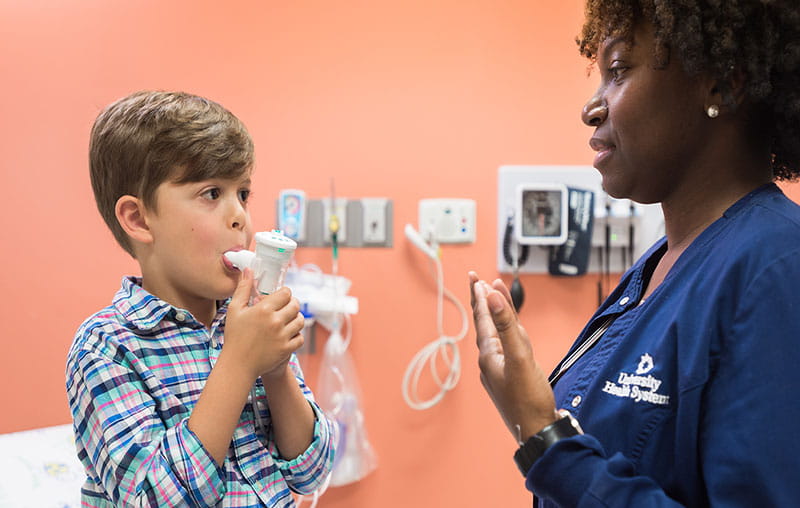When her son Benjamin started feeling sick, Julia Rodriguez first thought he had a stomach flu. The 7-year-old wasn’t able to keep his food down and acted very lethargic. After his condition worsened, Julia rushed him to the pediatrician’s office, where he was diagnosed with Type 1 diabetes.
“He was diagnosed in 2021, and my husband and I were just shocked,” Julia said. “We had no idea what Type 1 diabetes even was.”
The burden of managing his disease — glucose monitoring to check his blood sugar, along with painful insulin shots — weighed heavily on both Benjamin and his parents.
Now, a recent advancement in diabetes management technology greatly simplifies this process by closely mimicking the glucose regulating function of a healthy pancreas.
Bionic Pancreas for Type 1 Diabetes
The iLet Bionic Pancreas is an automated insulin delivery system that helps people with Type 1 diabetes reach their target blood glucose levels and improve their quality of life. Benjamin, now 10, started using the device in December and loves it, according to his mother.
“The bionic pancreas has been amazing for him,” she said. “His A1C and average blood sugar level are at the lowest they’ve been since he was diagnosed.”
How a Bionic Pancreas Works
In Type 1 diabetes, the pancreas makes little to no insulin, a hormone that helps blood sugar enter the cells in your body for use as energy. As a result, people with Type 1 diabetes need to take insulin multiple times every day to prevent blood sugar from building up in the bloodstream and causing damage to the body.
The iLet bionic pancreas system automatically monitors blood glucose levels throughout the day, calculates the amount of insulin needed every five minutes based on the glucose information, and delivers it under the skin from where it is absorbed into the body.
The system is made of three parts that work together to form a “closed loop”:
- A continuous glucose monitor (CGM) checks the user’s blood glucose level every few minutes using a tiny sensor under the skin.
- Dosing decision software receives input from the CGM and calculates how much insulin is needed to keep the user within a target range.
- An automated insulin pump delivers small doses of insulin based on that analysis to regulate blood glucose level every five minutes.
“It is a closed loop system, and what that means is that there is minimal to no input required from the wearer for insulin decisions,” said Dr. Rabab Jafri, a pediatric endocrinologist at University Health. “It really minimizes the daily work that somebody who has Type 1 diabetes needs to put in to keep their blood sugar in check.”
Getting FDA Approval for the Bionic Pancreas
The iLet Bionic Pancreas is initialized only with a user’s body weight and requires no additional insulin dosing parameters. Instead of conventional carb counting, a person with Type 1 diabetes simply estimates the amount of carbs in their meal as small, medium or large.
The device uses autonomous lifelong learning to calculate and deliver insulin doses and to continually adapt these doses to the user’s changing insulin needs. Changing needs can include periods of illness, new medications that affect blood sugars and menstrual cycles.
Texas Diabetes Institute Clinical Trial
In May 2023, the U.S. Food and Drug Administration (FDA) cleared the iLet Bionic Pancreas for people age 6 and older with Type 1 diabetes.
Patients from Texas Diabetes Institute participated in the pivotal clinical trial performed by UT Health San Antonio, University Health and other U.S. institutions that led to its long-awaited approval. The system is covered by Medicaid, Medicare and private health insurance.
“Families that came to the Texas Diabetes Institute for clinical care had the opportunity to be a part of this pivotal trial,” Dr. Jafri said. “This is a really exciting option for people who have Type 1 diabetes, and hopefully in the future, for people who have Type 2 diabetes as well.”
After getting a prescription from Dr. Jafri, Benjamin received his bionic pancreas within two months. It took a week or two to learn how to use the device, and the insulin infusion set must be changed every three days — but it definitely beats him taking multiple shots per day, says Julia.
“He was so excited to get it going. Right when we got it, he was ready to put it on,” Julia said. ”It’s been just amazing. It has made our life a lot simpler, and I would recommend it to any parent with a child who had Type 1 diabetes.”
Diabetes Care at University Health
Learn more about the world-class diabetes care at Texas Diabetes Institute in San Antonio.




